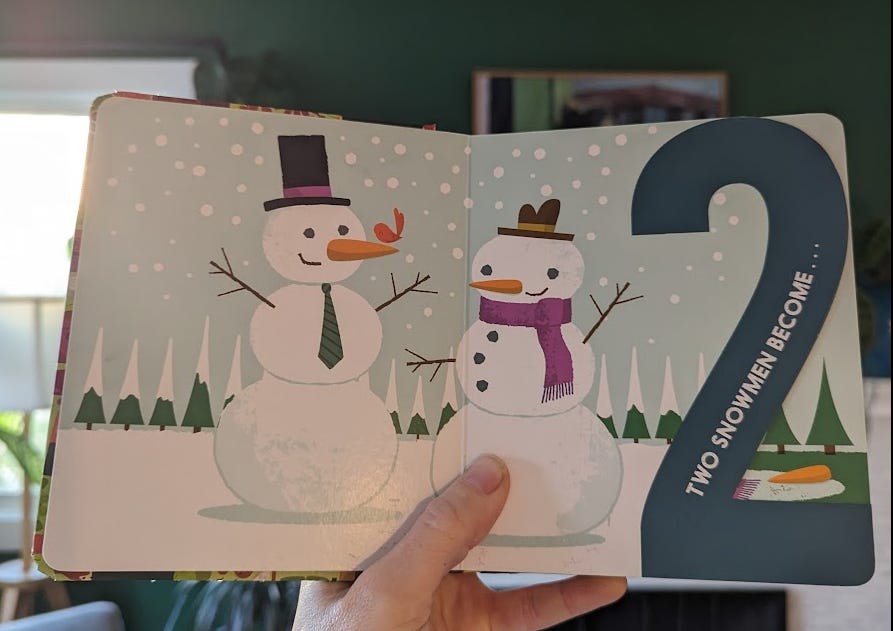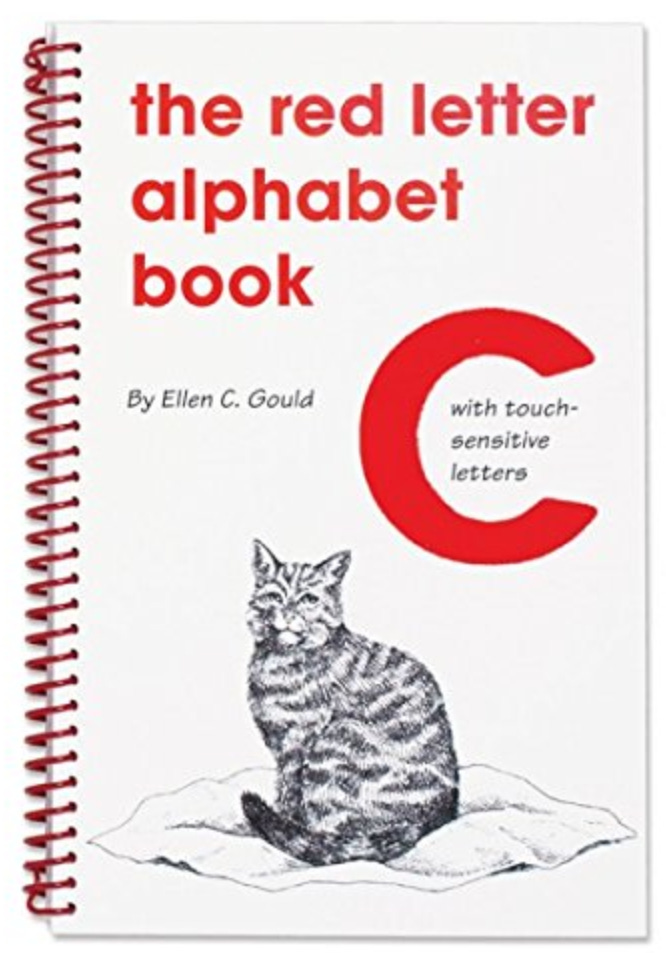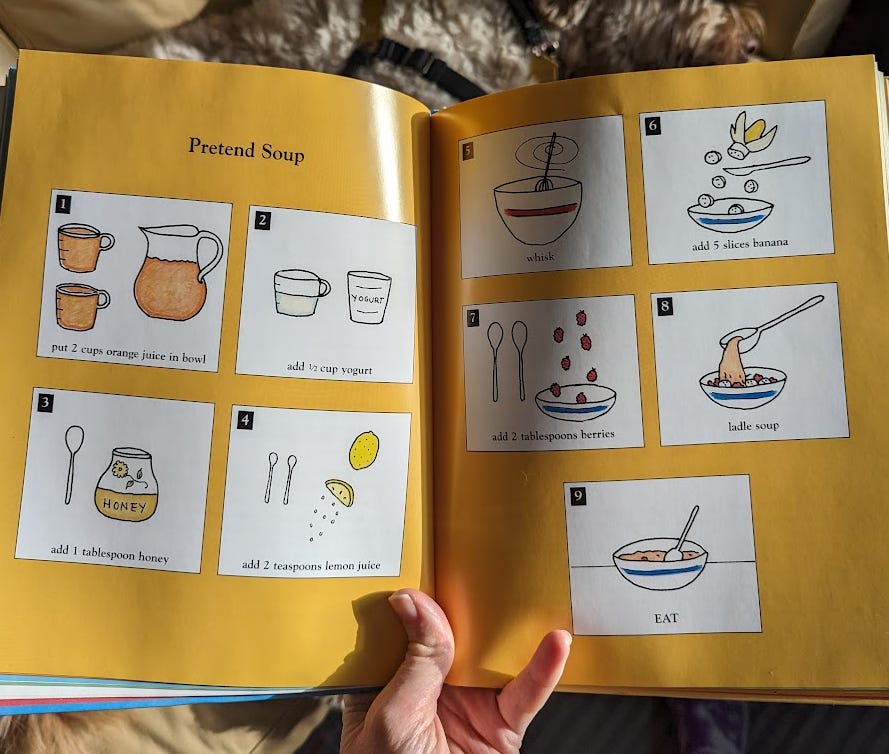Tis the season for the annual onslaught of influencers and advertisers trying to get us to buy, buy, buy! And here I go tossing my hat into the gift guide ring. If you want to stop right here and turn, instead, to a thoughtful give guide, go right ahead.
But - THESE book recommendations are different because they’re based on my professional experience as a career early childhood educator and trained reading specialist, as well as my personal experiences as a mom of two children under six. I structured the list so that each age has one nonfiction/academic type rec and one fiction/narrative type rec.
For transparency, I make a small (peanuts) commission when you use these links to buy books because they go through my Bookshop.org account. Using these links is less about the $$$ I make and more about the aggregate money you can provide to local bookshops. For example, my purchases go to benefit Green Bean Books — Portland locals, go check out their shop on NE Alberta Street. So a plea: if you’re going to buy online, consider using these Bookshop links to benefit small, independent bookstores (unlike the Big River Store).
And one final note before we get to the bookworm meat. If you follow my work, you know that I tend to bristle at age-based recommendations (children develop on their own, unique timelines, after all) so take these ranges with a hefty pinch of salt. Salty bookworm meat.
0-1 Year
Narrative-ish
Indestructibles are self-described as chew proof, rip proof, nontoxic, and 100% washable. They are simple, inexpensive, and, of course, relatively indestructible which means that your infant can mouth and touch them freely, thereby developing “book handling skills” in age-appropriate ways. Board books are great for this age group, but these provide a different motor experience because the pages are thin, more paper-like.
There are a bunch of versions out there, many of which are not the highest quality literature, but I don’t think you can go wrong with the simple song books and if you’re anything like me, you’ll benefit from having a few tangible reminders to sing to your baby. Here’s Row, Row, Row Your Boat which is a great place to start because dang it’s cute to hear a baby say, “row row row.” Browsing on your own is fun, but I added a few sing-song-y Indestructibles titles to my 0-6 month Bookshop list.
Academic-ish
Before I even recommend anything remotely “academic,” let me be very clear that the ultimate goal of reading with your child should be to develop a love of books through mutual enjoyment:
Following a baby’s gaze or pointing finger (as soon as they discover the immense power of the “royal point”) will help parents name objects the child is intrinsically interested in learning about. This is known in the research (which is admittedly limited to neurotypical children in my dominant culture) as “joint attention.” Joint attention refers to moments when the child and grown-up are focused on the same focal point, and it helps build vocabulary.
Like the Indestructibles, this “First 100 Words” series has many versions. I like them for this age group because young children develop a robust “receptive vocabulary” before they start producing their own words. Books that have a lot of images to point to (bonus points because they are real photographs) allow the child to direct their learning by essentially saying, “tell me about this” or “I’m interested in that” using their body language. Because they aren’t narrative in structure, adults are a bit less likely to speed through to the end. When you go slow enough to notice, you can figure out what your child is interested in — and then voilà: the grownup supplies the relevant language and the clever sponge soaks it up.
If you already have the classic First 100 Words by Roger Priddy (with hot nouns like dog, ball, & banana) then you may consider adding this seasonal take:
1-2 Years
Narrative
I have to include Harold Loves his Wooly Hat by Vern Kousky (even though it’s on backorder through Bookshop at the time of this writing) because it’s the first problem-based narrative book I remember my then one-year old truly getting.
In this book, Harold’s beloved hat is taken by a crow. Having someone take something away is a problem that Ed (a second sibling) very much comprehends. This book is simple enough to be accessed by an 18 month old, but complex enough to be enjoyed equally by our then four-year old who was able to access it at multiple other levels: the strategies used to get the hat back and the moral ambiguity of taking something away from someone to benefit others. Plus, that polar bear and striped cap make it so seasonal :)
Academic-ish
After listening to this episode of Your Parenting Mojo called Parenting Beyond Pink and Blue, I doubled down on talking to my daughter more about math and my son more about emotions. In a nutshell: research shows adults use more number words with young boys, and tend to focus more on little girls’ social-emotional understanding. My son loved Countablock by Christopher Franceschelli (literally loved it to smithereens, which is why we bought another copy for our daughter who also adores it).
Countablock begins by emphasizing the early math skill of number conservation (aka the quantity of a set doesn’t change if the set is rearranged).
I intentionally chose the only wintery pages to illustrate a seasonal example:
Then, Countablock goes all the way to 100, reiterating number conservation and providing ample opportunity for all sorts of other early math learning: one-to-one correspondence, hierarchical inclusion, number sequence, skip counting by 10’s, etc. I could geek out about this book even longer, but hopefully by now you’re picking up that I ten-out-of-ten recommend it (see what I did there?).
2-3 Years
Narrative
I am a big, huge Julia Donaldson fan. We have and love (like, LOVE) the original book, The Gruffalo. My two-and-a-half year old stomps around saying, “now my tummy’s beginning to rumble and my favorite food is gruffalo crumble!!”) so I think she’s going to be supremely stoked to open up this snowy sequel on Christmas morning:
In full disclosure, I’m not sure whether to recommend the board book or paperback version of Julia Donaldson’s books. Drew and I have read The Gruffalo to our children since birth because we enjoy reading it in silly voices (a plug for the board book version) but we’ve also continued to enjoy the book over and over again through the years (a plug for the bigger, paperback version). And, as an aside for fellow superfans, there are some high quality (but maybe slightly scary for some two-year-olds) animated shorts to watch.
Academic-ish
This is a recommendation I got from a podcast episode of Shelf Help titled, Using Montessori Materials at Home.
The Red Letter Book by Ellen C. Gould is a tactile book that allows children to trace velvet-y red letters with their fingertips.
It’s a bit different form a traditional alphabet book because it invites parents to focus on phonemic awareness (basically, the ability to hear and manipulate sounds plus the understanding that words are made up of sequences of sounds). Accordingly, the pages don’t exclusively include examples of words that start with the target letter. It also features examples of letter sounds showing up in the middle of familiar words:
This book is a big favorite in our house right now — Ed chooses it frequently as one of her nighttime books which allows us to very casually introduce letter-sound correspondence, a precursor to reading and writing!
3-4 Years
Narrative
Amy Wu and the Perfect Bao by Kat Zhang is a book I’ve recommended before and will recommend again. I love it for so many reasons: 1) the book features an intergenerational, non-white family with a dad who helps cook 2) the book provides many opportunities to talk about Amy’s feels as she is frustrated by her inability to do something modeled by her adults and 3) Amy - persistent and creative - is the person who ultimately figures out a solution.
Plus, the book features a family cooking together which is a big, huge part of the holidays and pairs well with my nonfiction rec for this age group.
Academic-ish
I found out about Pretend Soup by Mollie Katzen from an Instagram follower after I posted photos of my own “visual recipes.”
As a kindergarten and preschool teacher, I got into the habit of breaking down projects and recipes into easy-to-follow steps with visual cues to help children understand that print carries meaning (again, a precursor to reading and writing). The great thing about Pretend Soup is that Mollie Katzen, author of the well-loved Moosewood Cookbook, does it for you:
4-5 Years
Narrative
My mom, a devoted advocate for the reintroduction of wolves, gave us Bear and Wolf by Daniel Salmieri, and we (adults and kids alike) absolutely love it.
Bear and Wolf features - spoiler - a bear and a wolf who meet each other and go on a wintery walk together. This is a peaceful story that serves well as a bedtime book. The bear, refreshingly, is referred to using she/her pronouns and the wolf, refreshingly, is portrayed as a friend and teammate rather than the stereotypical villain. Also, the beautiful illustrations promote perspective-taking:
Academic-ish
A Seed is Sleepy by Dianna Hutts Aston is one of my all-time favorite books to teach. It’s an informational book about seeds and plants.
This book can be accessed on many different levels, depending on the amount of time you have/your child’s ability to receive the information. There are various sizes of font that help differentiate the level of information:
I’ve definitely learned from this book and its sister books.
5-6 Years
Narrative
I’m completely convinced that graphic novels are the perfect gateway to chapter books, and we are lucky to live during the full bloom of this particular genre. The Mr. Wolf Series by Aron Nels Steinke (local to Portland, woot woot) is one of Aldo’s current favorites. The series begins with this book, Mr. Wolf’s Class and progresses through the school year. Full disclosure: we do paraphrase these books a tiny bit to level up the kindness quotient.
So far, there are five books in the series. We have three and the remaining two will be underneath our tree this year. We like them because they are inclusive, realistic, and, with Aldo staring kindergarten this year, relevant to much of his life outside of our home. The comic book, frame-by-frame format allows Aldo some independence to interpret the story when he sits with the books independently. Plus there’s room for discussion and interpretation as we read though the books out loud.
Academic-ish
A children’s illustrated encyclopedia is great at this absorbent age. I couldn’t find the exact one we have, but here’s one from DK Publishing and another from DK/Eyewitness and also DK/Smithsonian.
Children are so full of questions and it’s nice to be able to reference a book instead of asking Google for some answers. Plus, to bring it full-circle, this type of book, full of convoluted pictures, allows children to lead their own learning (much like the aforementioned First 100 Words books). Because it’s not narrative in nature, children can bounce around, landing on pages that call to them. An all-around encyclopedia is a great place to start, but there are more specified, encyclopedic information books that go deeper and would be great options for children with more focused interests in sharks, castles, or birds, for example.
Okay, that’s a wrap! I love books. I love children. I love reading with children.
I hope you got an idea or two from reading this post. If you found it helpful, please consider sharing with a parent pal!
And if you have a title you think fellow readers should know about, please drop it in the comment section.
Bookworming,
Courtney























